1848 – US President James K. Polk triggers gold rush of 1849 by confirming a gold discovery in California
Miss Kitty and Gunsmoke
Enter now to win a copy of
Cowboys, Creatures and Classics: The Story of Republic Pictures

For more than nineteen years, Amanda Blake’s character on Gunsmoke, Miss Kitty, gave strength and succor to the parched patrons who visited Dodge City’s Longbranch Saloon. Kitty Russell was extremely softhearted, beneath what could be a very businesslike exterior, and would have willingly become romantically involved with Marshal Matt Dillon.
The few Westerns seen on television during the early 1950s starred old-style move heroes such as the Lone Ranger and Hopalong Cassidy, and had little to do with the real West. Two shows, Gunsmoke and The Life and Legend of Wyatt Earp, changed all that. Gunsmoke was set in Dodge City, Kansas, around 1880. It first began as a radio program starring William Conrad as Marshal Dillon and Georgia Ellis as Miss Kitty.
When Amanda Blake heard that the successful radio show was going to be made into a television pilot she knew she wanted to audition. Blake was born Beverly Louise Neill on February 20, 1929, in Buffalo, New York. She was educated in Buffalo, Gainesville, Georgia, and Claremont, Los Angeles County, where she moved with her parents in 1943.
Blake made her dramatic debut as a ten-year-old in a school pageant in Buffalo, and later studied acting at Buffalo’s Studio Club. She signed a contract with MGM while still in her teens, and her first film role was in the 1950 film Stars in My Crown.
“I knew I had to have the part of Kitty,” she told reporters in a 1971 interview. “So, I hounded the producer until I got it.” In order to do the long-running Gunsmoke series, Miss Blake commuted by private plane from her home near Phoenix. She left the show in 1974. “I was tired and it was time to go,” she recalled years later. “It was the end of the trail.”
Gunsmoke ran from September 10, 1955, to September 1, 1975. The show lasted only one year without Blake.
In 1968, Amanda Blake was selected as the first female inductee into the Hall of Fame of Great Western Actors and Actresses in Oklahoma City. She died of cancer in Sacramento, California, on August 16, 1989.
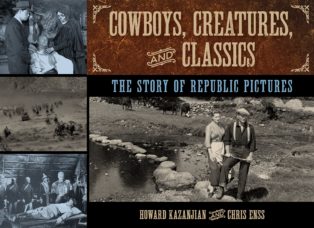
Cowboys, Creatures, and Classics 3
I'm looking forward to hearing from you! Please fill out this form and I will get in touch with you if you are the winner.
Join my email news list to enter the giveaway.
"*" indicates required fields
To learn more about the actress of television and film Westerns read
Cowboys, Creatures and Classics: The Story of Republic Pictures
This Day…
Republic Pictures’ Western Star Gail Davis
Enter now to enter to win a copy of
Cowboys, Creatures and Classics: The Story of Republic Pictures
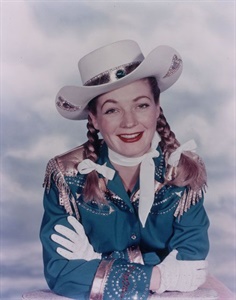
Bullseye! The Annie Oakley Show was on the air from 1954 to 1957 and Annie hit the entertainment bullseye every week with her hard riding, straight shooting, and suspense. Actress Gail Davis portrayed the Western legend. To some, Gail was only a minor flicker in the Hollywood star system. But to others, she was something special and more famous than that “other” Davis named Bette.
For more than three years she was TV’s pigtailed, fast-riding, sharp-shooting, good-looking Annie Oakley, who helped keep law and order in her hometown of Diablo through eighty-one black-and-white episodes. The series continues in re-runs for several years after that.
Davis was born in Little Rock, Arkansas and attended the University of Texas where she participated in college plays. From there she headed to Hollywood and landed her first small movie role in Romance of Rosy Ridge, a 1946 movie starring Van Johnson.
Next she had a part in If You Knew Susie with Eddie Cantor and Joan Davis at RKO. Not long after that, she began appearing as the female lead in some of the films of B-Western cowboy stars such as Allan “Rocky” Lane at Republic and Tim Holt at RKO.
She served herself well playing opposite Roy Rogers in 1949’s The Far Frontier. The movie also featured a couple of other figures who also would go on to make their marks in early TV Westerns: Clayton Moore (The Lone Ranger) and Andy Devine (“Jingles” on the Wild Bill Hickok Show).
Gene Autry spotted her, was impressed, and signed her to a contract with his Flying A Productions. Davis appeared as Autry’s leading lady in several of his theatrical movies.
When The Gene Autry Show was launched on television in the summer of 1950. Davis showed up in numerous episodes during the series’ first three years. Then Autry put Davis in her own show the “Annie Oakley” series which was produced by Flying A.
Also in the cast was Jimmy Hawkins as Annie’s brother Tagg and Brad Johnson as deputy sheriff Lofty Craig. After a taste of Annie’s deadeye shooting and Lofty’s hard-hitting fists, not many outlaws stayed around Diablo too long.
Appropriately, Annie’s horse in the series was named Target.
Flying A press agents claimed Davis grew up shooting and riding just like the real Annie Oakley. But in the early 1950s interview, Davis said she learned to ride and shoot after coming to Hollywood. Obviously, she picked up on it all quickly, because her shooting act became a part of Autry’s live touring show.
Gail Davis passed away in March 1997 of cancer. She was seventy-one when she died.

Cowboys, Creatures, and Classics 3
I'm looking forward to hearing from you! Please fill out this form and I will get in touch with you if you are the winner.
Join my email news list to enter the giveaway.
"*" indicates required fields
To learn more about the talented actress who portrayed Annie Oakley read
Cowboys, Creatures and Classics: The Story of Republic Pictures
This Day…
1903 – “The Great Train Robbery” the 1st Western film, released starring Justus D. Barnes and G. M. Anderson
The Devil Horse and the Stuntman
Enter now to win a copy of
Cowboys, Creatures and Classics: The Story of Republic Pictures
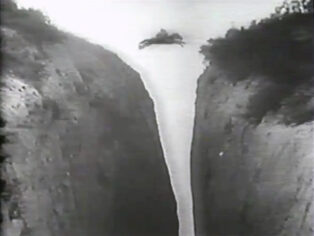
A pair of frantic, disheveled riders race side by side down a dusty, sun-scorched path. Suddenly they plunge into a wooded area. Branches slap at them, but neither dares slow his mount’s gait. They break through the other side, each still jockeying for lead position. The rider barely lagging behind now extends his arm out to grab the young man inches from him. The young man spurs his horse along faster and pulls away from the man trying to catch him. Ahead in the near distance, the crude path ends abruptly, giving way to a rocky cliff with a raging river far below. The two riders continue on fast, unaware of the danger. The young man is the first to leap off the precipice, his horse still under him. The rider behind him doesn’t hesitate but pushes his roan harder. The two fly off the cliff with great speed and plummet into the water.
The daring riders find their way to the surface. They’re dazed, but alive. The animals are alive as well, and they scramble to the water’s edge and hastily step out onto dry land.
After fighting the river’s strong current, both men managed to reach a sand bank and drag themselves out of the water. They are exhausted and drenched. The young man struggles to stand up and, once he finds his footing, hurries off after his horse. The cowboy that was chasing him hasn’t any strength left. He lies flat on his back staring up at the cliff where he dropped, contemplating how he could have survived such a fall.
That particular stunt was executed by legendary rodeo champion turned stuntman Yakima Canutt for the film The Devil Horse starring Harry Carey. Republic Pictures had a stable of daredevils who lived to perform death-defying feats that kept audiences on the edge of their seats. Yakima Canutt and the other stunt staff revolutionized the art and helped make Republic features and serial some of the most exciting and profitable works in the motion picture industry.

Contact
We would love to hear from you! Please fill out this form and we will get in touch with you shortly.
"*" indicates required fields
To learn more about Canutt and the other dedicated men and women who were willing to risk their lives for the movies produced by Republic read
Cowboys, Creatures and Classics: The Story of Republic Pictures
This Day…
Along Came Alice Sisty
Enter now to win a copy of
Along Came a Cowgirl: Daring and Iconic Women of the Rodeo and Wild West Shows
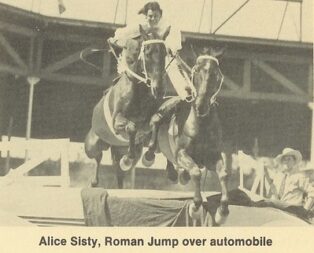
A hush fell over the large crowd at the rodeo arena in Salt Lake City, Utah, in July 1938 as daredevil rider Alice Sisty raced into the arena atop two English jumpers. She was standing on the backs of the animals with one foot on one horse and the other foot on the second mount, known as Roman riding. Alice led the horses into a gallop around the arena as the audience cheered and applauded. She expertly handled the jumpers named Whale and Brownstone. Alice had performed the Roman standard jump a number of times and was confident the trick would come off perfectly.
The trick involved the excited horses leaping over a parked automobile. It was an outstanding feat that, when executed well, brought rodeo fans out of their seats shouting for joy. Alice did not disappoint. Her signature jump was flawlessly carried out. She waved to the wildly cheering audience as she urged her horses into another pass at the stunt.
Born in Netcong, New Jersey, in January 1913, Alice first broke into national headlines when, at twenty years of age, she rode an Indian pony from Reno, Nevada, to the steps of New York City Hall. It was a three- thousand-mile journey, and, when she arrived in New York, mayors from coast-to-coast celebrated Alice’s accomplishment with letters of congratulations. The Cheyenne, Wyoming, Chamber of Commerce helped defray Alice’s expenses on the journey, and she helped advertise the Cheyenne Frontier Days by wearing a cowboy suit with the Cheyenne inscription on its back.
Alice had been riding horses since the age of six. Her grandfather owned a racetrack, and the love of horses was undoubtedly born in her. One of Alice’s first rodeo appearances was in Asbury Park. It was followed by well received appearances in such places as Des Moines, Iowa; Cheyenne, Wyoming; Omaha, Nebraska; and Billings, Montana. She performed at the Chicago World’s Fair and at Madison Square Garden.
Billed as a trick and fancy rider, Alice won numerous cowgirl championships. She was one of the highest paid, female rodeo performers in the 1930s. Friends and fans seldom, if ever, saw her without her makeup and hair done to perfection and adorned in beautiful cowgirl clothing. The dark-haired, blue-eyed Alice had decided to become a cowgirl when she was nineteen and signed to ride in Colonel Zack Millers’ 101 Ranch.
In addition to the prized English jumpers with which she used to perform the Roman standard jump trick; she owned a white Arabian horse named Chopa. Chopa was a highly intelligent animal who responded to every command of Alice’s voice. The pair were seen together in rodeo shows from coast to coast.
Alice passed away from an unnamed illness on September 11, 1953, in Crescent City, California, where she lived with her second husband, Hennie Sommer. Alice was forty years old when she died.
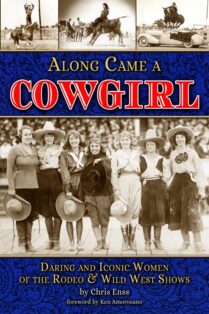
To learn more about fearless riders like Alice read
Along Came a Cowgirl: Daring and Iconic Cowgirls of the Rodeo and Wild West Shows
This Day…
1942 – “Casablanca” directed by Michael Curtiz and starring Humphrey Bogart and Ingrid Bergman premieres at Hollywood Theater, NYC (Academy Awards Best Picture 1943)
Along Came Cowgirl Tillie Baldwin
Enter now to win a copy of
Along Came a Cowgirl: Daring and Iconic Women of the Rodeo and Wild West Shows

Tillie Baldwin
Hundreds of rodeo fans filled every available seat at the Pendleton Roundup in northwestern Oregon in late September 1912. They cheered loudly for Swedish bronc buster Tillie Baldwin sitting atop an outlaw horse named Spike. The gate was moments away from opening and the bronc was already bucking wildly. Tillie ground her hat down tight on her head, and then clenched onto the thick reins of her ride. The chute opened and Spike darted out into the arena. Tillie bobbed up and down in the saddle, holding on with all her might, as the horse worked violently to try and throw her off his back. At long last, a horn sounded, and the ride was officially over. Tillie had survived the long trek around the arena on top an animal who had been unsuccessful in tossing her to the ground. The crowd enthusiastically applauded the twenty-four-year-old, and the remarkable ride earned her first prize in the women’s bucking bronco contest. She was awarded a $350 saddle. In addition to winning the bucking bronco championship, Tillie also won the trick riding competition and its $150 purse.
Tillie Baldwin was born Anna Mathilda Winger in Arendal, Norway, in 1888. She was fourteen years old when she migrated to the United States with her family in 1902, and she did not speak English. Six years later, she had not only mastered the language but had become a hairdresser with a healthy clientele of New York ladies wanting a new look.
During a trip to Staten Island in early 1908, Tillie saw a troupe of cowboy and cowgirl actors making a movie. The teenage hairdresser immediately wanted to learn to ride a horse and join the talent. Tillie approached one of the actors and asked them to teach her to ride. She worked for weeks with her paid instructor and eventually became a competent horsewoman. Shortly thereafter, she asked the producer of the film if she could join the cast. He agreed.
From those silent pictures, the eager young equestrian signed a contract to perform live in Captain Jack Baldwin’s Western Show. There she perfected her riding skills and met her husband, cowboy Johnny Baldwin. While employed in Baldwin’s show, she changed her name from Mathilda to Tillie. In time, she signed with the renowned 101 Ranch Wild West Show. When she wasn’t performing, she was competing in various rodeos around the country.
Over the course of her thirteen-year rodeo career, Tillie Baldwin won roping and riding events in such prestigious programs as the Winnipeg and Calgary Stampedes and the California Rodeo in Salinas. Routinely billed as the “fearless rider who had never been thrown by a bucking bronco”, rodeo fans in 1921 named her as one of three best women riders in the country. Also on that list were Fannie Sperry and Bertha Blanchard.
Tillie retired from rodeo competition in 1925 and moved to South Lyme, Connecticut, where she operated a horse ranch and riding school. She died on October 23, 1958, at the age of seventy.

To learn more about talented riders like Tillie read
Along Came a Cowgirl: Daring and Iconic Women of the Rodeo and Wild West Shows

